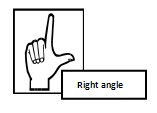 When working with fractions, many of my students seem confident in performing the different operations, but a few are still unsure of how to reduce fractions.
When working with fractions, many of my students seem confident in performing the different operations, but a few are still unsure of how to reduce fractions. Although I have stressed learning the Divisibility Rules for 2, 5, 10, and the digital root for 3, 6, 9, some still have difficulty since they do not know their multiplication tables. As a mathematics tool, I have the students make Pattern Sticks, a visual and kinesthetic aid, similar to a multiplication chart like the one on the left. Notice that an extra column (blue) has been added to the chart. (In this space, a hole is punched so that a 1" ring can be inserted to store all of the sticks in one place.)
 On the right are the directions for making the Pattern Sticks using a multiplication chart.
On the right are the directions for making the Pattern Sticks using a multiplication chart. (Side note: My students cut out individual Pattern Sticks which I prefer over cutting a multiplication chart apart.)
 I then give the students fractions such as 9/36 to reduce. Using the Pattern Sticks, they search for a column where a 9 and a 36 are lined up in the same column. They easily find it on the 1 strip and the 4 strip. They then take the two strips and line them up so that the 9 is over the 36. (see illustration above) By moving to the left, they discover that 9/36 is the same as 1/4. This is 9/36 in its lowest terms. Also notice that all the fractions in the illustration are equivalent fractions - fractions that have the same value. The Pattern Sticks can also be used to determine what number to divide by and to change improper fractions to mixed numbers.
I then give the students fractions such as 9/36 to reduce. Using the Pattern Sticks, they search for a column where a 9 and a 36 are lined up in the same column. They easily find it on the 1 strip and the 4 strip. They then take the two strips and line them up so that the 9 is over the 36. (see illustration above) By moving to the left, they discover that 9/36 is the same as 1/4. This is 9/36 in its lowest terms. Also notice that all the fractions in the illustration are equivalent fractions - fractions that have the same value. The Pattern Sticks can also be used to determine what number to divide by and to change improper fractions to mixed numbers. |
| $3.00 |




